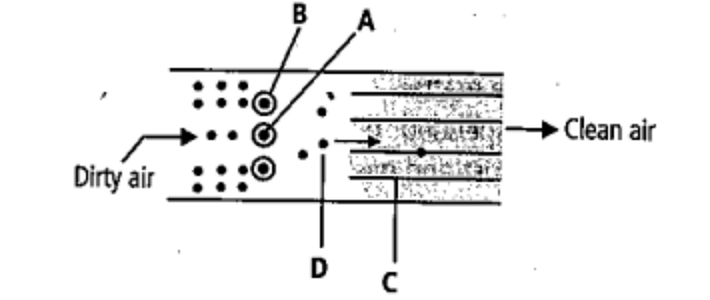Test: Air Pollution (Old NCERT) - NEET MCQ
20 Questions MCQ Test Biology Practice Tests: CUET Preparation - Test: Air Pollution (Old NCERT)
The given figures represent two devices A and B used to control air pollution. Identify them and select the correct answer.

Which of the following is a method used to get rid of particulate matter present in the exhaust from a thermal power plant?
| 1 Crore+ students have signed up on EduRev. Have you? Download the App |
Given below is a diagram of electrostatic precipitator identify A, B, C and D and select the correct option.


Increased asthmatic attacks in certain seasons are related to
Which of the following statements are correct?
(i) Benzene hexachloride (BHC) is a non-biodegradable pollutant.
(ii) Anthropogenic air pollutants are natural in origin.
(iii) Carbon monoxide is a primary air pollutant.
(iv) Sulphur dioxide causes brown air effect during traffic congestion in cities.
In India, Air (Prevention and Control of Pollution ) Act came into force in the year 1981, but was amended in the year ____ to include ____ as an air pollutant.
Which one of the following statements is incorrect regarding Bhopal gas tragedy?
Which of the following is the way to control vehicular air-pollution in Indian cities?
Read the given statements and select the correct option.
Statement 1: Traffic jams are likely to cause giddiness, exhaustion, reduced vision, etc.
Statement 2: Carbon monoxide from vehicles causes these problems by reducing O2 carrying capacity of haemoglobin.
Study the following statements regarding acid rain and select the incorrect ones.
(i) Acid rain refers to the rainfall and other forms of precipitation with a pH of less than 5.
(ii) Oxides of sulphur and nitrogen are released from automobile exhausts, industries, power plants, etc.
(iii) These oxides of sulphur and nitrogen, may react with water in the air and form sulphuric acid (H2SO4) and nitric acid (HNO3)
(iv) Acid rain has harmful effects on animals and human beings but no characteristic impact on plants.
Chemicals responsible for the Bhopal gas tragedy were
Which of the following is the most dangerous metal pollutant of automobile exhaust?
Choose the correct sequence of air pollution and its components with the effect it produces
Chlorofluorocarbons are air polluting agents which are produced by
Peroxyacyl nitrates (PAN) are formed through photo-chemical reactions between
Given below are some differences between primary air pollutants and secondary air pollutants.
Which one of the following is an incorrect difference?

Which one of the following statements regarding CO gas is correct?


















